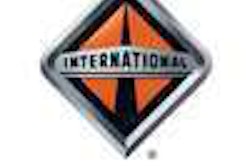Mike Lutmer, co-owner of Lutmer Farms, monitors his vehicle’s weight with TruckWeight’s wireless SmartScale reader.
While Mike Lutmer loads his dump trailer with grain, topsoil, limestone, road salt or any other material, he pulls out a handheld device. On the screen is a picture of a truck. Using arrow keys, Lutmer moves a flashing bar under each axle set to see which one can take on more weight legally.
Lutmer – co-owner of Lebanon, Ohio-based Lutmer Farms – operates a three-axle rear dump trailer with an air-ride suspension. About two years ago, he purchased the SmartScale wireless onboard scale system from TruckWeight. Before, he depended on platform scales to maximize his legal payload; when loading limestone at a quarry, the quarry workers would distribute most of the load toward the rear.
“I was finding myself constantly overloaded even though they used platform scales,” says Lutmer, who by law is allowed 42,000 pounds of payload in his three-axle trailer. However, having an uneven distribution of the weight on the axles often meant being overweight by 3,000 pounds. “If I get pulled over, it doesn’t matter if I am under gross,” he says. “I’ll get a ticket.” Lutmer looked at several weighing systems before deciding to use TruckWeight’s wireless handheld system, and the portability of the handheld display was a key factor.
Besides helping fleets stay legal, onboard weighing systems can eliminate the time, fuel and costs associated with using commercial platform scales.
When looking at the systems on the market today, fleets have two categories from which to choose: analog and digital. Onboard scales that use analog systems are designed exclusively for air suspensions and use interior- and exterior-mounted needle gauges to display weight. Analog systems cost less than digital, but digital systems can be configured to fit more types of equipment, and they offer more communications and display options.
Affordability is the primary driver for the sales of RightWeigh’s analog onboard scales, says Scott McCulloch, the company’s director of communications. Earlier this year, one of the nation’s largest refrigerated carriers, Prime Inc., outfitted its entire trailer fleet with 4,500 RightWeigh scales. The model 310-54 exterior scales installed by Prime are RightWeigh’s most popular scale and retail for $195, McCulloch says.
Compared to analog, electronic scales offer more flexible configurations for fleets with equipment that has mechanical spring suspension systems on one or more axles. Vehicles in the auto hauling, refuse, construction and logging industries often use spring suspensions. To get accurate weight ratings, the major providers of electronic onboard scales – Air-Weigh, TruckWeight and Vulcan Scales – use a deflection sensor, which is mounted directly on suspension components to measure the component deflection and convert the deflection into a corresponding weight.
Besides displaying weights in the cab, some systems can send weight information back to the office in real time. Air-Weigh transmits tractor and trailer weight information to the vehicle’s J1708 or J1939 communications channel, where it can be picked up by onboard computers and sent to the office. So far, DriverTech is the only onboard computing provider to make this option available to customers, says Jim Morton, Air-Weigh product manager.
Air-Weigh onboard scales cost $915 for a tractor and $685 for a trailer; prices go down with volume. This year, the company introduced a more basic system called the QuickLoad scale for $400, which provides axle weights without extra features such as printing and the J1708 interface.
TruckWeight plans to launch a new platform this month called Fleet Link to communicate sensor information – weight and identification number – to fleets’ mobile communication devices. Fleets can have an electronic record of what trailer is hooked to what tractor, as well as the trailer’s weight.
With this data, fleets will be able to monitor real-time weights on the truck, as well as on tractor-trailer combinations. TruckWeight also is preparing to launch a desktop software package called Free Loader that fleets can use to receive real-time weight information from the trucks in a yard via short-range wireless communications.
“It’s a simple program that anyone can use,” says Peter Panagapko, president of TruckWeight.
Equipment is no longer a limiting factor in selecting onboard scales; the real difference is in price and functionality. The price advantage of analog combined with the expanded functionality of electronic onboard scales creates demand for both types of products.











